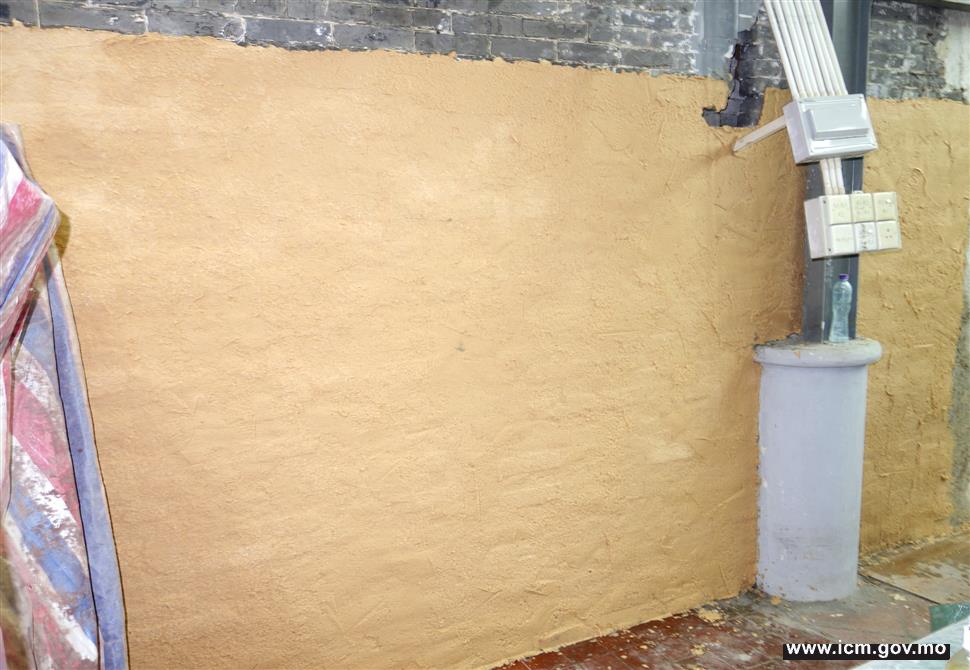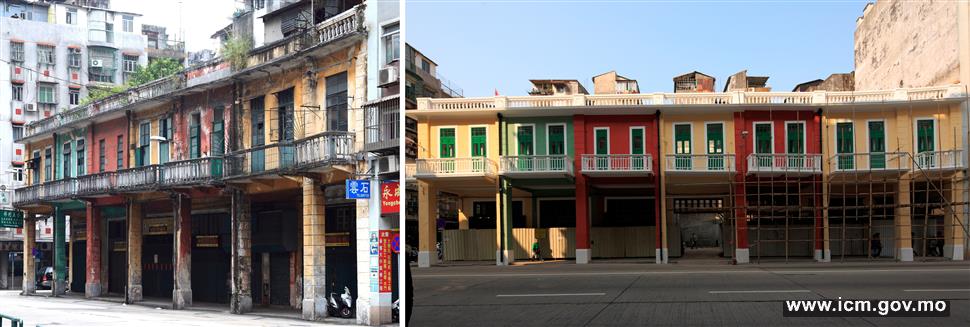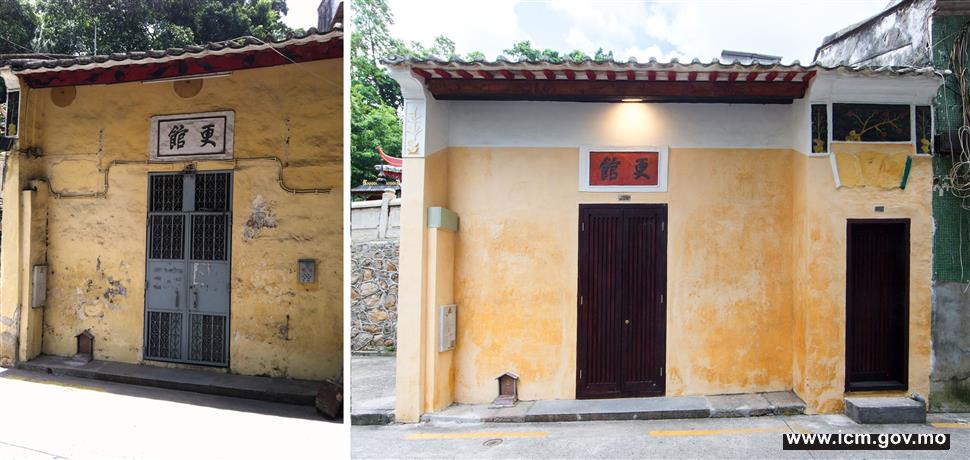Does Heritage Need A Medical Drip When Ailing?
In the hospital, it is common to see sick patients on a drip feed. In the same way, when heritage is ailing, the restoration team of the Cultural Affairs Bureau can ‘restore’ it with a ‘medical drip’.
Built in 1587, St. Dominic’s Church, located at St. Dominic’s Square, is the first church established by the Dominican Order (Dominicans) on Chinese soil. The church is elaborately embellished, and especially noteworthy is the fact that it was built with a special type of green bricks, which are twice the size of normal green bricks. In the early stages of the construction, clay-sand subsoil plastering and lime wash were used.
As Macao’s underground water is rich in salt, the walls of St. Dominic’s Church have been damaged over the years by the crystallized salt in the water, leading to severe flaking and peeling-off of the wall plaster, causing weathering and erosion.
In the past, the restoration team attempted to protect the edifice with low-pressure injection moulding, but the outcome was not satisfactory. The structure still showed hollowing, peeling-off, brittleness and salt crystallization. The church walls are one meter thick, with a dense compaction of green bricks saturated with salt water, which increases the difficulty of conservation. Yet, the team was not discouraged - with comprehensive studies and analysis, alongside creativity and wisdom, they invented a 'targeted titration system' to inject a ‘treatment solution’ into the green bricks. In tests, water and salt were successfully removed from the green bricks, and the result was satisfactory. Thus, the team undertook this conservation method to restore the edifice, providing a ‘medical drip’ to the walls of St. Dominic’s Church, which is a spectacular feat!
The ‘Architectural’ Mind and Carving of Dragons
In heritage conservation, if one is willing to understand the ‘heart’ of the architecture, one will unearth its innermost secrets. During the restoration work on two plasterworks in Lin Fong Temple, the restoration team of the Cultural Affairs Bureau discovered assorted bright and rich colours deep in the plasterworks. Upon painstaking and appropriate treatment, the original colours of the plasterworks were brought to light.
The two conventional plasterworks in the yard of Lin Fong Temple feature vivid soaring dragons and leaping fish. It was discovered that the external layers of the plasterworks peeled off, became brittle and were contaminated with modern emulsion paint. After careful examination, the restoration team discovered that there were more than 10 layers of emulsion paint on the plasterworks, thus they first removed the non-conforming modern emulsion paint and preserved the original colour as much as possible. After studying the distribution of colours in different layers, the team found that the original colours on the plasterworks were in good condition and bright. As a result, the conservation team decided to maintain the original colour of the plasterworks by filling them up with traditional clay ingredients, reinforcing and maintaining the material, they then enhanced the colours by using mineral lime wash. A permeable mineral protective solution was used on the surface of the plasterworks so that the original colours could be demonstrated.
As we can see, there is a treasure trove of heritage stories. Windswept and battered by rain over the years, heritage structures may temporarily lose their initial appearance, but with delicate observation and detailed studies, their true needs can be perceived, and by seeking through the innumerable methods of conservation, the most appropriate approach can be found.
Love Me, Don’t Touch Me
The Section of the Old City Walls, which stands beside the Ruins of St. Paul’s, served as a defence fortification in the past. Over the years, the walls lost their initial function, and now they can be compared to a historical textbook that silently narrates history to visitors. As the flow of visitors to the Ruins of St. Paul’s increases, sometimes they may touch these ancient walls. Little do they know that the slightest touch can greatly harm the walls.
The Section of the Old City Walls was built with chunambo. However, the materials used to produce chunambo are very rare and the traditional production method is almost lost. In recent years, an inestimable numbers of tourists have visited the area of the Ruins of St. Paul’s, and damaged the Section of the Old City Walls by just touching them. Chunambo is obtained by the physical pressing of natural ingredients with handmade wooden battens, without any combustion or chemical processes. As a result, touching causes the sand and soil on the outer surface of the walls to peel off. If thousands of tourists touched the walls, the damage would be very evident.
The climate in Macao is humid and rainy. If modern materials are used to protect the chunambo,it will lose its permeability and adhesiveness, thus peeling off upon weathering; this in turn will further affect the chunambo on the walls. Eventually, conservation practitioners took reference from foreign information on the topic, and they invited local technicians, who had produced chunambo in the past, to give their opinions on the matter and study the ingredients of chunambo scientifically. Subsequently, they prepared a material whose quality is similar to chunambo, with which they coated the surface of the chunambo as a protective layer. It is equally easy for this new material to peel off; therefore it should also not be touched.
As of now, the two surviving segments of the old city walls are located near the Ruins of St. Paul’s and Mount Fortress. Compared to the chunambo in the Ruins of St. Paul’s segment, the material of the Mount Fortress segment is more solid, therefore it is not easy to collect samples, which adds to the difficulty of conserving the walls. Heritage conservation requires the public participation. In order to protect our defensive walls and city walls - please don’t touch them!
Lu Ban Carpentry Exhibition: Face Mask for Green Brick Wall?
Skincare is one of the important routines for beauty-lovers. Nowadays, regardless of gender, men and women use masks to improve their skin, sometimes using masks for their eyes, mouths, and even arms and legs. But have you heard that the Cultural Heritage needs mask treatment, too?
The restoration staff uphold the belief that according to different architectural characteristics, conservation for Cultural Heritage requires various techniques and approaches. The Lu Ban Carpentry Exhibition located in Rua de Camilo Pessanha is primarily formed by the main hall and the exhibition hall. In the past, due to seawater intrusion, the walls of the building had been saturated by saltwater. In a situation like this, staff will generally remove the water and salt from the walls to prevent further corrosion and impact on the structure. However, the wall material of the exhibition hall and main hall is different; for the walls in the exhibition hall, it may use improved lime render to fix the saltwater problem and prevent the crystallisation of salts inside the walls. But for the main hall built of green bricks, this kind of plastering is unfavourable to keeping the architectural feature of green brick.
Thus, the restoration practitioners came up with another way to clear the salt – using a ‘paper mask on the wall’ (salt scavenging paper pulp). The theory of this method is to apply a special kind of paper pulp on the green brick wall of the main hall after damping the paper pulp, and then use a dehumidifier to extract the water from the paper pulp, thereby extracting the salt in the green brick wall as well. This approach ensures the effect of salt scavenging whilst conserving the architectural feature of the green brick walls.
Hence, even in the same geographical environment, various restoration methods have to be used according to different architectural features. If carried out improperly, the restoration work may backfire and cause damage to the Cultural Heritage. As with our skin, it is only if we apply skincare treatment suitable for our skin condition that we will have a positive outcome!

Wall under ‘Mask Treatment’
Patane Old Houses: Matching the Original Colour
If you passed by the Rua da Ribeira do Patane on a bus, you would probably be attracted by the old buildings on both sides of the road; in particular, the seven old houses standing side by side. Located at No. 69-81, Rua da Ribeira do Patane, these houses are typical veranda-type shop houses in Macao built in the 1930s, with the ground floor for commercial use and upper floors for residential use. These houses have their heritage value for conservation thus in the restoration process the workers preserved their original façades and repainted them, in the hope of restoring the vibrant colours of these seven buildings.
Located near the sea, these old buildings were deeply affected by years of weathering, adding to the difficulty of restoration. Prior to restoration, there were even plants growing on the walls of the building, indicating that water had saturating the building, a great disadvantage to the restoration work. As a result, the treatment of the walls had to wait until the strengthening works for the building were completed before the workers could repair the walls with traditional lime wash paints. However, traditional lime wash is very rare nowadays, and its manufacturing skills and applying procedure almost non-existent in Macao; due to high humidity, modern paints would only aggravate the decay of the buildings since they could not breathe.
In order to restore the façades to their original lustre, the restoration workers found an open space in Coloane to make the lime wash using traditional materials like limestone and straw grass; this kind of lime wash was more compatible with that on the walls, which had good ‘breathability’, and when used with clay ingredients and mineral lime wash as protection it could help the walls withstand the heat and humidity near the sea. On the other hand, the lime wash paints indoor was relatively soft and after several tests, ink rather than mineral pigment was applied to some parts of the walls to restore their original colour.
Thus, the seven colourful buildings you see when you pass by the Rua da Ribeira do Patane are an achievement of the long-term restoration planning and effort. An old resident expressed that the appearance of the buildings after restoration was exactly the same as the old one and reminded her of her childhood. To restore heritage to its original colour, the restoration work has to try to match the colour to the greatest extent.

Prior to Restoration / After Restoration
Patane Night Watch House: Reviving the Bygone Days of the Night Watch
‘Night watch’ may sound unfamiliar to the young generation nowadays. In the past, the watch was sounded by the night watchmen, with changing sound and rhythm to indicate different times of the night. In addition to telling the time, the night watch also performed the function of a patrol; in case of a fire or theft, the night watchmen would help fight fires and catch thieves.
At No. 52-54, Rua da Palmeira, there is an old house with the inscription ‘Night Watch House’ hung over the door. Here is the place where the former night-watchmen prepared for their work. Following the decline of the profession of night watch, many night watch houses were shut down, with no more existed except for the one and only Patane Night Watch House, standing in long-term disrepair. Prior to restoration, the staff found that the roof and a wall had collapsed; they also discovered a white doorplate whose plaster characters had peeled off because of the contamination with modern emulsion paint. The Night Watch House at that time was in great need of repair.
The restoration practitioners first repaired the roof with traditional Chinese roof-building methods, later rebuilding the broken wall with complete, old bricks. For the restoration of the façade of the Night Watch House, after removing the modern emulsion paint, the workers used traditional clay ingredients to refill and repair the damaged plaster characters (‘Night Watch House’) and repainted it with traditional lime wash to restore it to its original state.
The rear part of the Night Watch House was built against a giant rock clinging to Jardim de Luís de Camões; according to staff members, building the house against the rock formed a solid foundation, meanwhile in Chinese feng shui (literally ‘wind-water’, a Chinese philosophical system) the stone is an object of good fortune. But since the stone was connected to the hill, during rainy days the water would go down from the stone to the inside of the building; thus the workers excavated a drain around the stone to direct the rain outdoors.
The principle of heritage conservation is to ‘restore the old to its old form’- genuinely reflecting every detail of the heritage of its past, original condition. Just like the Patane Night Watch House, today it may have finished its historical mission and become a witness to bygone days; through restoration, the old house has been returned to its original state enabling people to understand the life of the past. Whatever the degree of damage to the Cultural Heritage, the ‘Cultural Heritage doctors’ will shoulder their mission to preserve and restore the architectural heritage for the next generation.

Prior to Restoration / After Restoration